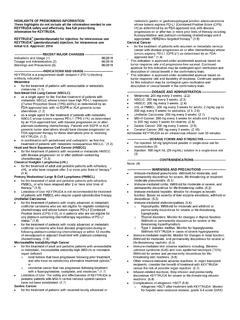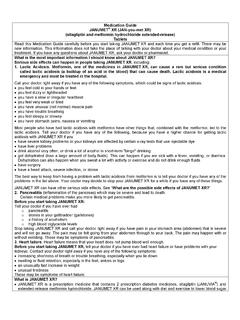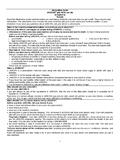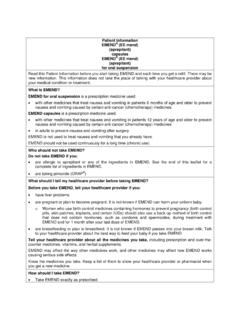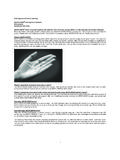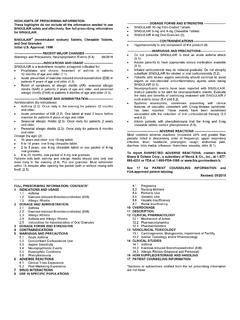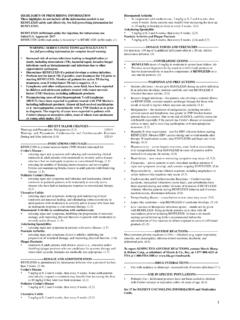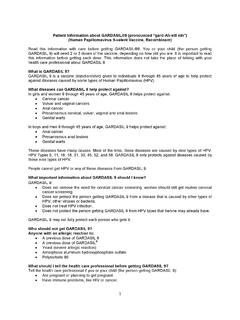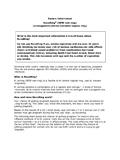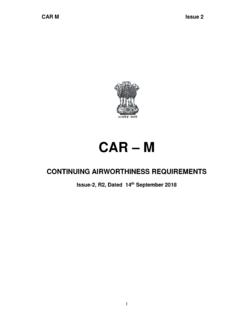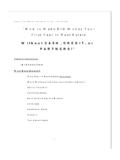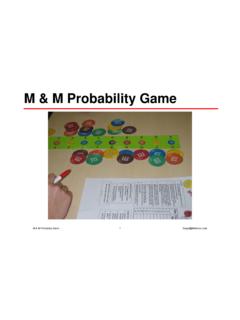Transcription of M-M-R II (MEASLES, MUMPS, and RUBELLA VIRUS VACCINE …
1 1M-M-R II(MEASLES, MUMPS, andRUBELLA VIRUS VACCINE LIVE)DESCRIPTIONM-M-R II(Measles, Mumps, and RUBELLA VIRUS VACCINE Live) is a live VIRUS VACCINE for vaccination against measles (rubeola), mumps, and RUBELLA (German measles).M-M-RIIis a sterile lyophilized preparation of (1)ATTENUVAX (Measles VIRUS VACCINE Live), a more attenuated line of measles VIRUS , derived from Enders' attenuated Edmonston strain and propagated in chick embryo cell culture; (2) MUMPSVAX (Mumps VIRUS VACCINE Live), the Jeryl Lynn (B level) strain of mumps VIRUS propagated in chick embryo cell culture; and (3) MERUVAX II( RUBELLA VIRUS VACCINE Live), the Wistar RA 27/3 strain of live attenuated RUBELLA VIRUS propagated in WI-38 human diploid lung fibroblasts.{1,2}The growth medium for measles and mumps is Medium 199 (a buffered salt solution containing vitamins and amino acids and supplemented with fetal bovine serum) containing SPGA (sucrose, phosphate, glutamate, and recombinant human albumin) as stabilizer and growth medium for RUBELLA is Minimum Essential Medium (MEM) [a buffered salt solution containing vitamins and amino acids and supplemented with fetal bovine serum] containing recombinant human albumin and neomycin.
2 Sorbitol and hydrolyzed gelatin stabilizer are added to the individual VIRUS cells, VIRUS pools, and fetal bovine serum are all screened for the absence of adventitious reconstituted VACCINE is for subcutaneous administration. Each dose contains not less than1,000 TCID50(tissue culture infectious doses) of measles VIRUS ; 12,500 TCID50of mumps VIRUS ; and 1,000 TCID50of RUBELLA VIRUS . Each dose of the VACCINE is calculated to contain sorbitol ( ), sodium phosphate, sucrose ( mg), sodium chloride, hydrolyzed gelatin ( mg), recombinant human albumin ( mg), fetal bovine serum (<1 ppm), other buffer and media ingredients and approximately 25 mcg of neomycin. The product contains no reconstitution, the lyophilized VACCINE is a light yellow compact crystalline plug. M-M-RII, when reconstituted as directed, is clear PHARMACOLOGYM easles, mumps, and RUBELLA are three common childhood diseases, caused by measles VIRUS , mumps VIRUS (paramyxoviruses), and RUBELLA VIRUS (togavirus), respectively, that may be associated with serious complications and/or death.
3 For example, pneumonia and encephalitis are caused by measles. Mumps is associated with aseptic meningitis, deafness and orchitis; and RUBELLA during pregnancy may cause congenital RUBELLA syndrome in the infants of infected impact of measles, mumps, and RUBELLA vaccination on the natural history of each disease in the United States can be quantified by comparing the maximum number of measles, mumps, and RUBELLA cases reported in a given year prior to VACCINE use to the number of cases of each disease reported in 1995. For measles, 894,134 cases reported in 1941 compared to 288 cases reported in 1995 resulted in a decrease in reported cases; for mumps, 152,209 cases reported in 1968 compared to 840 cases reported in 1995 resulted in a decrease in reported cases; and for RUBELLA , 57,686 cases reported in 1969 compared to 200 cases reported in 1995 resulted in a decrease.{3}Clinical studies of 284 triple seronegative children, 11 months to 7 years of age, demonstrated that M-M-RIIis highly immunogenic and generally well tolerated.
4 In these studies, a single injection of the VACCINE induced measles hemagglutination-inhibition (HI) antibodies in 95%, mumps neutralizing antibodies in 96%, and RUBELLA HI antibodies in 99% of susceptible persons. However, a small percentage (1-5%) of vaccinees may fail to seroconvert after the primary dose (see also INDICATIONS AND USAGE,Recommended Vaccination Schedule).A study{4} of 6-month-old and 15-month-old infants born to VACCINE -immunized mothers demonstrated that, following vaccination with ATTENUVAX, 74% of the 6-month-old infants developed detectable neutralizing antibody (NT) titers while 100% of the 15-month-old infants developed NT. This rate of seroconversion is higher than that previously reported for 6-month-old infants born to naturally immune mothers tested by HI assay. When the 6-month-old infants of immunized mothers were revaccinated at 15 2months, they developed antibody titers equivalent to the 15-month-old vaccinees. The lower seroconversion rate in 6-month-olds has two possible explanations: 1) Due to the limit of the detection level of the assays (NT and enzyme immunoassay [EIA]), the presence of trace amounts of undetectable maternal antibody might interfere with the seroconversion of infants; or 2) The immune system of 6-month-olds is not always capable of mounting a response to measles VACCINE as measured by the two antibody is some evidence to suggest that infants who are born to mothers who had wild-type measles and who are vaccinated at less than one year of age may not develop sustained antibody levels when later revaccinated.
5 The advantage of early protection must be weighed against the chance for failure to respond adequately on reimmunization.{5,6}Efficacy of measles, mumps, and RUBELLA vaccines was established in a series of double-blind controlled field trials which demonstrated a high degree of protective efficacy afforded by the individual VACCINE components.{7-12} These studies also established that seroconversion in response to vaccination against measles, mumps, and RUBELLA paralleled protection from these diseases.{13-15}Following vaccination, antibodies associated with protection can be measured by neutralization assays, HI, or ELISA (enzyme linked immunosorbent assay) tests. Neutralizing and ELISA antibodies to measles, mumps, and RUBELLA viruses are still detectable in most individuals 11 to 13 years after primary vaccination.{16-18} See INDICATIONS AND USAGE, Non-Pregnant Adolescent and Adult Females, for RUBELLA Susceptibility RA 27/3 RUBELLA strain in M-M-RIIelicits higher immediate post-vaccination HI, complement-fixing and neutralizing antibody levels than other strains of RUBELLA VACCINE {19-25} and has been shown to induce a broader profile of circulating antibodies including anti-theta and anti-iota precipitating antibodies.
6 {26,27}The RA 27/3 RUBELLA strain immunologically simulates natural infection more closely than other RUBELLA VACCINE viruses.{27-29} The increased levels and broader profile of antibodies produced by RA 27/3 strain RUBELLA VIRUS VACCINE appear to correlate with greater resistance to subclinical reinfection with the wild VIRUS ,{27,29-31} and provide greater confidence for lasting AND USAGER ecommended Vaccination ScheduleM-M-RIIis indicated for simultaneous vaccination against measles, mumps, and RUBELLA in individuals 12 months of age or first vaccinated at 12 months of age or older should be revaccinated prior to elementary school entry. Revaccination is intended to seroconvert those who do not respond to the first dose. The Advisory Committee on Immunization Practices (ACIP) recommends administration of the first dose of M-M-RII at 12 to 15 months of age and administration of the second dose of M-M-RIIat 4 to 6 years of age.{32} In addition, some public health jurisdictions mandate the age for revaccination.
7 Consult the complete text of applicable guidelines regardingroutine revaccination including that of high-risk adult Outbreak ScheduleInfants Between 6to 12 Months of AgeLocal health authorities may recommend measles vaccination of infants between 6 to 12 months of age in outbreak situations. This population may fail to respond to the components of the VACCINE . Safety and effectiveness of mumps and RUBELLA VACCINE in infants less than 12 months of age have not been established. The younger the infant, the lower the likelihood of seroconversion (see CLINICAL PHARMACOLOGY). Such infants should receive a second dose of M-M-RIIbetween 12 to 15 months of age followed by revaccination at elementary school entry.{32}Unnecessary doses of a VACCINE are best avoided by ensuring that written documentation of vaccination is preserved and a copy given to each vaccinee's parent or Vaccination ConsiderationsNon-Pregnant Adolescent and Adult FemalesImmunization of susceptible non-pregnant adolescent and adult females of childbearing age with live attenuated RUBELLA VIRUS VACCINE is indicated if certain precautions are observed (see below and PRECAUTIONS).
8 Vaccinating susceptible postpubertal females confers individual protection against subsequently acquiring RUBELLA infection during pregnancy, which in turn prevents infection of the fetus and consequent congenital RUBELLA injury.{33}3 Women of childbearing age should be advised not to become pregnant for 3 months after vaccination and should be informed of the reasons for this ACIP has stated "If it is practical and if reliable laboratory services are available, women of childbearing age who are potential candidates for vaccination can have serologic tests to determine susceptibility to RUBELLA . However, with the exception of premarital and prenatal screening, routinely performing serologic tests for all women of childbearing age to determine susceptibility (so that VACCINE is given only to proven susceptible women) can be effective but is expensive. Also, 2 visits to the health-care provider would be necessary one for screening and one for vaccination. Accordingly, RUBELLA vaccination of a woman who is not known to be pregnant and has no history of vaccination is justifiable without serologic testing and may be preferable,particularly when costs of serology are high and follow-up of identified susceptible women for vaccination is not assured.
9 "{33}Postpubertal females should be informed of the frequent occurrence of generally self-limited arthralgia and/or arthritis beginning 2 to 4 weeks after vaccination (see ADVERSE REACTIONS).Postpartum WomenIt has been found convenient in many instances to vaccinate RUBELLA -susceptible women in the immediate postpartum period (see PRECAUTIONS, Nursing Mothers).Other PopulationsPreviously unvaccinated children older than 12 months who are in contact with susceptible pregnant women should receive live attenuated RUBELLA VACCINE (such as that contained in monovalent RUBELLA VACCINE or in M-M-RII) to reduce the risk of exposure of the pregnant planning travel outside the United States, if not immune, can acquire measles, mumps, or RUBELLA and import these diseases into the United States. Therefore, prior to international travel, individuals known to be susceptible to one or more of these diseases can either receive the indicatedmonovalent VACCINE (measles, mumps, or RUBELLA ), or a combination VACCINE as appropriate.
10 However, M-M-RIIis preferred for persons likely to be susceptible to mumps and RUBELLA ; and if monovalent measles VACCINE is not readily available, travelers should receive M-M-RIIregardless of their immune status to mumps or RUBELLA .{34-36}Vaccination is recommended for susceptible individuals in high-risk groups such as college students, health-care workers, and military personnel.{33,34,37}According to ACIP recommendations, most persons born in 1956 or earlier are likely to have been infected with measles naturally and generally need not be considered susceptible. All children, adolescents, and adults born after 1956 are considered susceptible and should be vaccinated, if there are no contraindications. This includes persons who may be immune to measles but who lack adequate documentation of immunity such as: (1)physician-diagnosed measles, (2)laboratory evidence of measles immunity, or (3)adequate immunization with live measles VACCINE on or after the first birthday.{34}The ACIP recommends that "Persons vaccinated with inactivated VACCINE followed within 3 months by live VACCINE should be revaccinated with two doses of live VACCINE .
